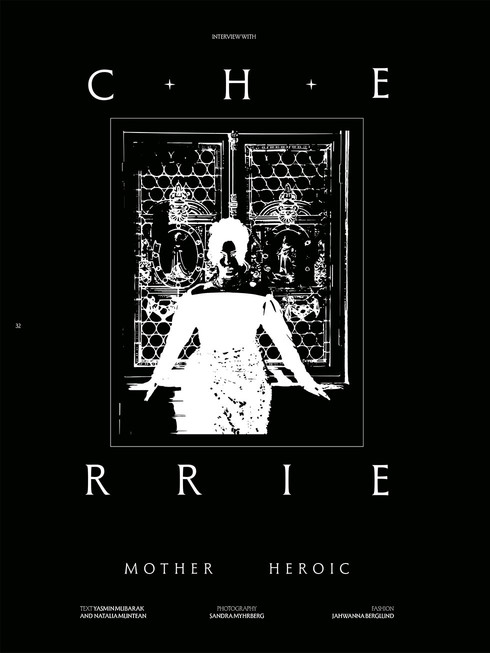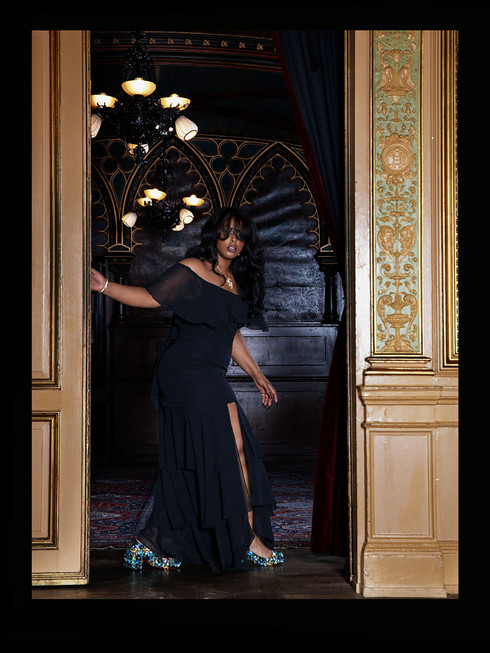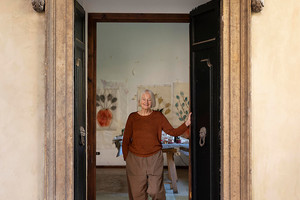An Interview with Cherrie
Written by Natalia Muntean by Sandra MyhrbergFor over a decade, Cherrie has remained a dynamic force in Scandinavian music, blending soulful R&B with personal and cultural influences. Known for breaking boundaries with her independent releases, Cherrie is entering her ‘Obsidian Era,’ where she fully embraces her duality—balancing strength and vulnerability, tradition and innovation. Her latest project, built on resilience and creative free- dom, not only marks her growth as an artist but also as a leader in nurturing emerging talent. With a particular focus on empowering women through her label, Araweelo, Cherrie is working to create a supportive ecosystem of female entrepreneurs and creators. From sold-out shows in Brooklyn to offering mentorship to local artists like Saru, her influence continues to expand both in and out of the studio.
WITH FOUR ALBUMS BEHIND HER, SHE NOW FOCUSES ON CRAFTING STANDALONE SINGLES THAT CONNECT ON A DEEP- ER EMOTIONAL LEVEL, ALL WHILE MAKING STRIDES IN FASH- ION AND MENTORING THE NEXT GENERATION OF ARTISTS.
Odalisque Magazine: You’ve just released a range of new songs this year. Can you share the inspiration behind them?
Cherrie: The crazy thing is, there’s a whole backstory to these new songs. This is the sixth single I’ve released independently, a great thing for me, especially doing it in times of economic recession. It’s been such a blessing to be able to put out music on my own, with the help of my friends. It’s called the Obsidian Era because I am very focused on the Obsidian gemstone. It’s a symbol of change and strength - having the courage to go through these changes and maintain a sense of independence. I went into my first era during the pandemic and returning to the independent label work style I was used to felt like a scary change. I didn’t want to release an album this time, because I had already released four. But I still wanted to create new music and for the singles to have a cohesive sound, and be a part of each other. As a Gemini, I often see things from different perspectives, and I wanted that duality to come through. Most importantly, though, I wanted to come back to real R&B with this release.
OM: Tell me about your latest song, ‘Lack.’ Where does it fit into your Obsidian Era?
Cherrie: The latest single, called Lack, means “angry” or “mad” in Swedish. It’s about love, broken trust, and being fed up. You can also view those more aggressive emotions from differentperspectives. My songs this year have all explored different feelings: one was about independence, another about love, one about being truthful, and another about life. It’s about embracing the duality of your emo- tions. I feel like Lack is just an extension of this Obsidian Era—a year of returning to indie music and creating everything I’ve done independently.
OM: Why is it called the Obsidian Era?
Cherrie: The reason why it’s called the Obsidian era is because of what the gemstone represents. It’s a black gemstone with stripes of colour and white in it, just like how I feel my music is. I grew up on Scandinavian pop, but at heart, I’m still an African girl who loves black RnB and Hip Hop, with a twist of Afrobeat. I also have to mention that I’m a real nerd—I love sci-fi. If you’ve ever watched Game of Thrones, you’ll know the stone they used to destroy the ‘bad guys’ was Obsidian, which I think is very cool too. So, it’s kind of an extension, representing the duality in everything I do.
OM: Being known and praised for your soulful R&B, are there any new directions or genres you’re interested in exploring coming back?
Cherrie: I wouldn’t say I’m heading in a different direction, it’s more about exploring and developing the genre I’m already immersed in. R&B, for instance, stands for Rhythm and Blues—it’s such a broad genre that’s evolved and grown over many years. I feel the need to explore different directions within the music I love. It’s a genre from which almost all pop music stems, which is why you can hear similarities when you listen to pop today. Or why R&B blends so easily with hip-hop. Not to mention, Blues even inspired Rock. For me, my artistic growth lies in continuing to explore what R&B is, without losing my identity. With my African roots, I also want to honour that heritage, drawing inspiration from Somali and West African music, or even Afro Beats. Lately, I’ve also been getting into Bollywood music from India, which I think is cool. I always want to push the boundaries and expose myself to different genres. As a songwriter and producer, in all aspects, I’m constantly striving to push myself and the music I create.
OM: How was it to become an independent artist again, and have control over your creation?
Cherrie: This year, I had a big plan for what I wanted to do when I became independent again. But making that jump was scary. Going from having a team of 40 people working around you to having to do everything yourself – from PR releases to editing your music videos. But this is what I love, the fact that I can dive into the different aspects of being an independent artist and share my art with everyone.
OM: I have seen you have been working with fashion a lot, for example with your sister, how was that?
Cherrie: I feel like I’ve been working a bit in the shadows during these past few years and now I can finally show my work to everyone. A lot is coming this year, and I am very excited about it.
On the fashion side, there is a lot of development. My sister has started working a lot with fashion content, so being able to work with her is so much fun. I love to work with family and have us growing together side by side. To help each other and just be part of each other’s projects. Everything I have been working on for the last couple of years makes me super excited to show it to all next year, I feel like there is a lot to look forward to. For example, I will be going on an international tour next year, which I am super excited about.
OM: With a busy schedule and a lot of different projects, what do you enjoy during your time off?
Cherrie: A lot of my time goes into music because I love it. When I’m in Sweden and not traveling – it might sound boring, but you’ll find me in the studio, reading a book, or discovering an awesome sci-fi or anime show to watch. Being single also gives me the space to enjoy my own company – I love taking long walks or going to the gym to relax and work on myself. I think it’s important to have those days too. But the studio is my main thing, even on off-days. I’m lucky to have a studio at home, which makes everything so much easier – I can keep my creativity flowing and sing whenever I want. I love just chilling there, where I can relax while still being creative. I feel like those are my real “me” days. It’s a way to express myself, like self-medication in a sense. That’s how I usually spend my time.
OM: What have been some of the biggest challenges you’ve faced as an independent artist, and how have you overcome them?
Cherrie: This year, it’s been scary because, suddenly, you have young freelancers and people working for you, and you’ve got to make sure everyone is working so they can eat and feel like they have a purpose in your project. I’m very keen on ensuring that the people who work with me feel like they are part of something bigger that elevates all of us. That’s a huge thing for me as a business owner. As an independent, you have a lot of different tasks to manage. You have to wear the branding hat, the man- agement hat—just everything. The challenge is definitely more on the administrative side of being independent. For example, budgeting can be tough if you don’t get help from a consultant. It’s mainly about finding the time to get everything done. But I wouldn’t have it any other way.
OM: Do you have any advice for others?
Cherrie: With branding and PR as an artist, it will take time. It can be very tough to get your music on public playlists and have someone who knows the industry push it towards radio, but I’ve been blessed that this part has been working quite well for me. This year specifically, I think my music stands out from others – and that makes it easier to connect with listeners. And being nice to people, while wearing all these different hats, is so important. As a solo artist, it can be tough when you’re stressed and on a huge tour with shows every night. With today’s technology, you can literally record demos on your phone. It’s that accessible. It’s easy to learn different crafts on YouTube, including how to download free beats and learn to record. Be comfortable with how you record yourself because it’s very different from just singing without a mic or performing on stage. I’d say, first and foremost, the music is yours and yours alone, so make sure your product is something you fully own and understand – know the goal and the meaning behind it. Really train yourself to gain that control. Especially if you’re a woman in a room full of men, stick with your gut and do what you want to do. Own the production; it’s important. When you do get into those big business meetings or studio sessions, you’ll be prepared for what you need to bring to the table. And when you’ve trained in that area, things usually start falling into place. So, what I tell most of my friends when they ask is: Just start with your computer and a simple mic, and learn to record yourself. That way, you’ll at least have demos ready when you get into those rooms where you need to introduce yourself.
OM: You have very devoted fans, could you describe what they mean to you, and can you share a memorable interaction with a fan?
Cherrie: I’ve had some amazing fan interactions over the years. I can’t put one above the other. But the best one this year would be when I was doing a show in Malmö and 40,000 people were singing along to a song that I released 10 years ago, and they sounded crazier than a football stadium. It was this amazing group of people, I saw people standing in the front singing their hearts out to the music, and that gave me goosebumps. So that’s the craziest fan interaction I’ve had this year and that I will never forget.
OM: You mentioned the importance of strong women in your life. How do your personal experiences and relationships shape your music and overall artistic vision?
Cherrie: I grew up surrounded by strong women—it wasn’t really a choice, that’s just how it was for me. I’m constantly amazed by their strength and what femininity does to save the world. I’ve never stopped being inspired by women. That’s why I work so hard, and I work hard for myself because all the women in my life have done and continue to do that. It’s also a way for me to have fun. If I were to start making lighthearted music that didn’t have a deeper connection, it wouldn’t make sense, especially when I have all these amazing personalities around me. So, it’s just second nature, I guess. Also, as I’m getting closer to turning 33, there’s so much feminine energy—amazing energy— that just keeps evolving and growing. You can hear it in the music, in the vision, in everything. And honestly, not even my favourite artists inspire me as much as my sisters, my girlfriends, and my mom. That should tell you everything.
OM: You sometimes have projects outside of the music industry. Is this something you like, and feel that you can be creative about?
Cherrie: I love making music videos, and that’s one way to visually represent what you want to say with the music. I see frequency sounds; it’s when you can see certain emotions through colours. A lot of my music videos are very community-based, with people from both my new and old communities, but I still use things like colours— pastels and sunsets—to give it that playful edge. It’s the same when it comes to beauty and other creative expressions, and I’m definitely going to, and want to, venture into other areas. I’m excited about that, and I feel like this opportunity I’m getting now is a step toward that. I’m so grateful for it.
























